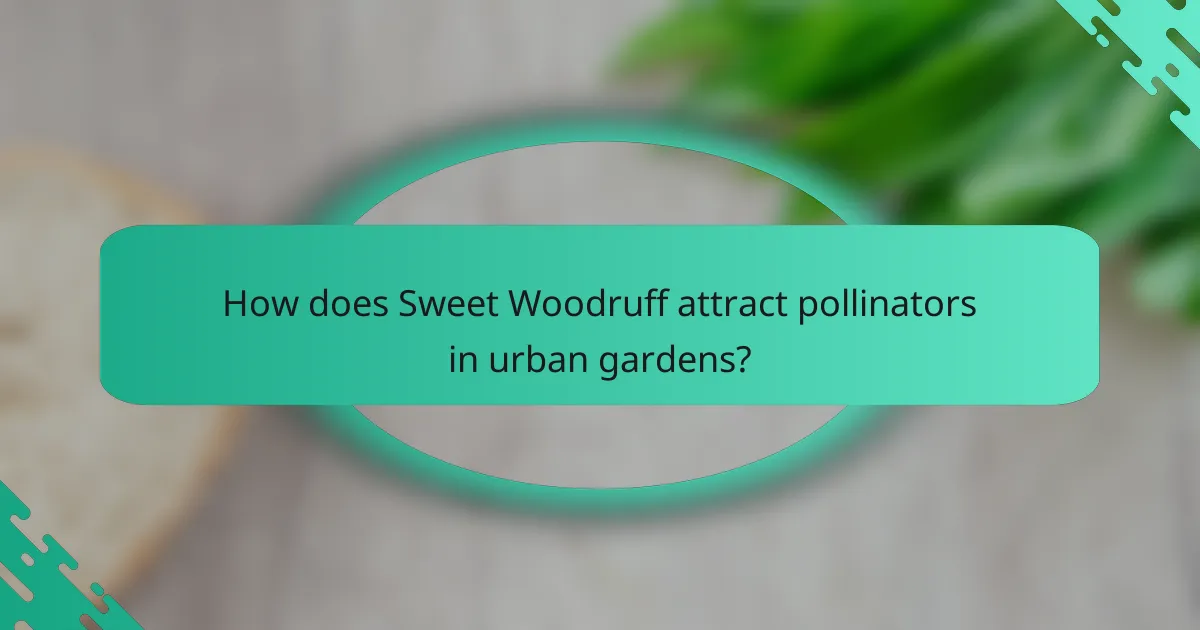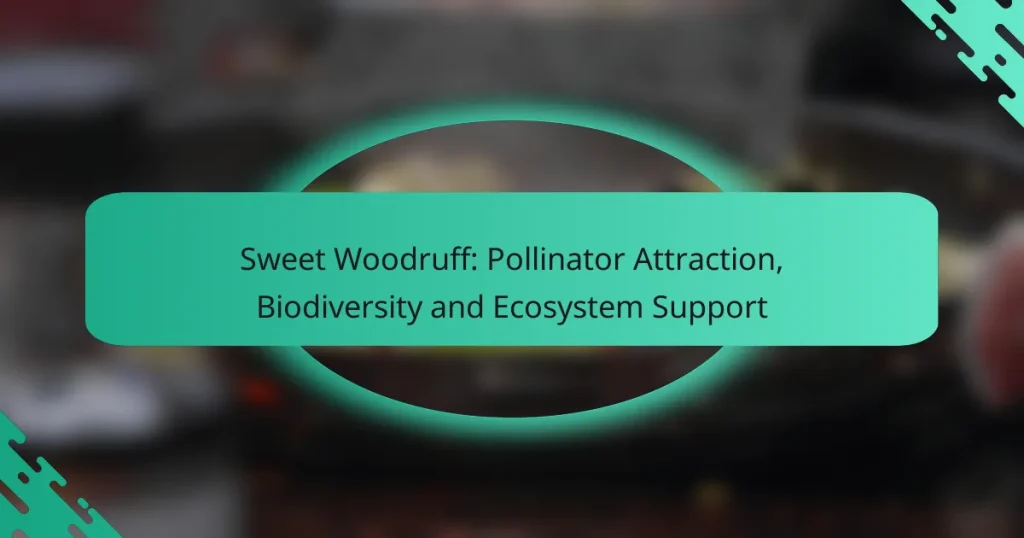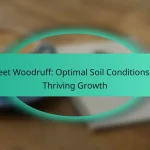Sweet Woodruff is a valuable plant for urban gardens, attracting pollinators with its rich nectar and pollen, which are vital for various species’ survival. Beyond supporting pollinator health, it enhances biodiversity and provides ecological benefits such as improving soil health and reducing erosion, making it an ideal choice for both aesthetic and environmental purposes in landscaping.

How does Sweet Woodruff attract pollinators in urban gardens?
Sweet Woodruff attracts pollinators in urban gardens primarily through its abundant nectar and pollen, providing essential food sources for various species. This plant not only supports pollinator health but also enhances biodiversity in urban environments.
Provides nectar and pollen
Sweet Woodruff produces small, white flowers that bloom in spring, offering a rich source of nectar and pollen. These flowers are particularly attractive to bees, butterflies, and other pollinators, making them an excellent addition to any garden focused on supporting wildlife. The flowering period typically lasts several weeks, ensuring a consistent food supply during this time.
To maximize pollinator attraction, consider planting Sweet Woodruff in clusters. This arrangement makes it easier for pollinators to locate the flowers and encourages them to visit more frequently.
Supports diverse pollinator species
By attracting a variety of pollinators, Sweet Woodruff contributes to a balanced ecosystem in urban gardens. Species such as honeybees, bumblebees, and various butterflies are commonly seen visiting these plants, each playing a vital role in pollination and plant reproduction. This diversity helps maintain healthy plant populations and promotes ecological resilience.
Encouraging a mix of flowering plants, including Sweet Woodruff, can further enhance the variety of pollinators in your garden. Aim for a range of bloom times and colors to attract different species throughout the growing season.
Enhances garden aesthetics
In addition to its ecological benefits, Sweet Woodruff adds visual appeal to urban gardens. Its lush green foliage and delicate white flowers create a charming ground cover that can complement other plants. This aesthetic quality makes it a popular choice for garden designers looking to create inviting outdoor spaces.
Consider using Sweet Woodruff in shaded areas or as a border plant. Its ability to thrive in low-light conditions allows it to fill gaps in the garden while enhancing overall beauty and biodiversity.

What are the ecological benefits of Sweet Woodruff?
Sweet Woodruff offers several ecological benefits, including enhancing soil health, supporting local biodiversity, and reducing erosion. These advantages make it a valuable addition to gardens and natural landscapes.
Improves soil health
Sweet Woodruff contributes to soil health by enhancing organic matter content and promoting beneficial microbial activity. Its dense root system helps to aerate the soil, improving drainage and nutrient availability.
Incorporating Sweet Woodruff into your garden can lead to healthier soil over time, making it easier for other plants to thrive. Consider planting it in shaded areas where it can flourish without competition from sun-loving species.
Supports local biodiversity
This plant plays a crucial role in supporting local biodiversity by providing habitat and food for various pollinators, including bees and butterflies. Its flowers attract these beneficial insects, which are essential for the pollination of many crops and wild plants.
By cultivating Sweet Woodruff, you can create a more diverse ecosystem in your garden. This not only benefits pollinators but also contributes to the overall health of the local environment.
Reduces erosion
Sweet Woodruff helps reduce soil erosion through its extensive root network, which stabilizes the soil and prevents runoff. This is particularly important in areas prone to erosion, such as slopes or along waterways.
Planting Sweet Woodruff in vulnerable areas can be an effective strategy to protect the soil and maintain landscape integrity. Regular maintenance, such as mulching, can further enhance its erosion control capabilities.

How can Sweet Woodruff be integrated into local landscaping?
Integrating Sweet Woodruff into local landscaping enhances both aesthetics and ecological health. This versatile ground cover thrives in shaded areas, supports biodiversity, and requires minimal upkeep, making it an excellent choice for various garden designs.
Ideal for shaded areas
Sweet Woodruff is particularly well-suited for shaded areas, thriving under trees and in spots that receive limited sunlight. Its ability to flourish in low-light conditions makes it a valuable addition to gardens where other plants may struggle.
When planting Sweet Woodruff, consider locations with dappled sunlight or full shade. This plant can create a lush green carpet, effectively suppressing weeds while adding visual interest to shaded landscapes.
Companion planting with other native species
Sweet Woodruff works well in companion planting schemes, especially with other native species. Pairing it with plants like ferns or hostas can enhance biodiversity and create a harmonious ecosystem in your garden.
When selecting companions, look for plants that share similar moisture and soil requirements. This not only promotes healthy growth but also attracts a variety of pollinators, contributing to a vibrant garden environment.
Low maintenance requirements
One of the key benefits of Sweet Woodruff is its low maintenance requirements. Once established, it requires minimal watering and can thrive in various soil types, making it an ideal choice for busy gardeners.
To keep Sweet Woodruff healthy, occasional trimming may be necessary to control its spread. However, it generally does not require fertilization, allowing you to enjoy a beautiful landscape with little effort.

What are the best practices for cultivating Sweet Woodruff?
To cultivate Sweet Woodruff successfully, focus on providing the right soil, adequate moisture, and seasonal care. This perennial plant thrives in specific conditions that support its growth and ability to attract pollinators.
Optimal soil conditions
Sweet Woodruff prefers well-drained, loamy soil rich in organic matter. Aim for a slightly acidic to neutral pH, ideally between 5.5 and 7.0, to promote healthy growth.
Incorporating compost or well-rotted manure can enhance soil fertility and structure. Avoid heavy clay soils that retain too much moisture, as this can lead to root rot.
Watering and fertilization tips
Maintain consistent moisture in the soil, especially during dry spells. Water Sweet Woodruff regularly, ensuring the soil remains damp but not waterlogged.
Fertilization should be minimal; a balanced, slow-release fertilizer applied in early spring can support growth. Over-fertilizing can lead to excessive foliage at the expense of flowering.
Seasonal care guidelines
In spring, remove any dead leaves and debris to encourage new growth. This is also the best time to divide the plants if they have become overcrowded.
During the summer, monitor for pests and diseases, but generally, Sweet Woodruff is resilient. In fall, cut back the foliage after it has died back to prepare for winter dormancy.

What are the potential challenges of growing Sweet Woodruff?
Growing Sweet Woodruff can present several challenges, including its potential for invasive growth, pest management, and adaptability to varying climate conditions. Understanding these issues is crucial for successful cultivation and maintaining local biodiversity.
Invasive growth in some regions
Sweet Woodruff is known to spread rapidly in certain environments, particularly in moist, shaded areas. This invasive tendency can lead to it outcompeting native plants, disrupting local ecosystems. Gardeners should monitor its growth closely and consider containment strategies, such as planting in pots or using barriers.
To manage its spread, regular pruning and removal of excess plants can help maintain balance in the garden. It’s advisable to check local regulations regarding invasive species to ensure compliance and protect native biodiversity.
Pest management strategies
While Sweet Woodruff is generally resilient, it can attract pests like aphids and spider mites. Regular inspections can help identify infestations early, allowing for prompt action. Organic pest control methods, such as introducing beneficial insects or using insecticidal soap, can effectively manage these issues without harming the plant.
Implementing companion planting with pest-repelling species can also enhance pest management. Avoiding excessive nitrogen fertilizers can reduce susceptibility to pests, as overly lush growth can attract them.
Climate adaptability issues
Sweet Woodruff thrives in cooler, temperate climates but may struggle in extreme heat or drought conditions. In regions with hot summers, providing partial shade and consistent moisture is essential for healthy growth. Understanding your local climate’s characteristics can inform the best practices for cultivation.
When planting Sweet Woodruff, consider its hardiness zone and select varieties suited to your specific climate. Mulching can help retain soil moisture and regulate temperature, improving adaptability in challenging conditions.

How does Sweet Woodruff contribute to ecosystem support?
Sweet Woodruff plays a vital role in ecosystem support by providing habitat and food sources for various wildlife species. Its dense growth and fragrant flowers attract pollinators, enhance biodiversity, and contribute to soil health.
Enhances habitat for wildlife
Sweet Woodruff creates a rich habitat for wildlife, particularly in shaded woodland areas. Its ground cover provides shelter and nesting sites for small mammals and birds, while its flowers attract essential pollinators like bees and butterflies.
By fostering a diverse range of species, Sweet Woodruff contributes to a balanced ecosystem. This plant can thrive in various soil types and moisture levels, making it adaptable to different environments, which further supports local wildlife populations.
To maximize its benefits, consider planting Sweet Woodruff in areas with partial to full shade and moist, well-drained soil. Avoid over-fertilizing, as this can lead to excessive growth that may outcompete other native plants, reducing overall biodiversity.


